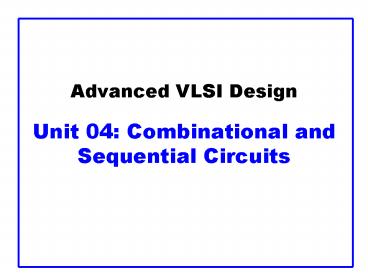Advanced VLSI Design Unit 04: Combinational and Sequential Circuits - PowerPoint PPT Presentation
1 / 20
Title:
Advanced VLSI Design Unit 04: Combinational and Sequential Circuits
Description:
Advanced VLSI Design Unit 04: Combinational and Sequential Circuits Outline Basic CMOS Circuits Combinational Circuits Sequential Circuits Transistors as Switches We ... – PowerPoint PPT presentation
Number of Views:187
Avg rating:3.0/5.0
Title: Advanced VLSI Design Unit 04: Combinational and Sequential Circuits
1
Advanced VLSI DesignUnit 04 Combinational and
Sequential Circuits
2
Outline
- Basic CMOS Circuits
- Combinational Circuits
- Sequential Circuits
3
Transistors as Switches
- We can view MOS transistors as electrically
controlled switches - Voltage at gate controls path from source to drain
4
CMOS Inverter
A Y
0
1
5
Inverter Cross-section
- Typically use p-type substrate for nMOS
transistors - Requires n-well for body of pMOS transistors
6
Inverter Mask Set
- Transistors and wires are defined by masks
- Cross-section taken along dashed line
7
Complementary CMOS
- Complementary CMOS logic gates
- nMOS pull-down network
- pMOS pull-up network
- a.k.a. static CMOS
Pull-up OFF Pull-up ON
Pull-down OFF Z (float) 1
Pull-down ON 0 X (crowbar)
8
Gate Layout
- Layout can be very time consuming
- Design gates to fit together nicely
- Build a library of standard cells
- Standard cell design methodology
- VDD and GND should abut (standard height)
- Adjacent gates should satisfy design rules
- nMOS at bottom and pMOS at top
- All gates include well and substrate contacts
9
Example NAND3
- Horizontal N-diffusion and p-diffusion strips
- Vertical polysilicon gates
- Metal1 VDD rail at top
- Metal1 GND rail at bottom
- 32 l by 40 l
10
Pseudo-nMOS
- In the old days, nMOS processes had no pMOS
- Instead, use pull-up transistor that is always ON
- In CMOS, use a pMOS that is always ON
- Ratio issue
- Make pMOS about ¼ effective strength of pulldown
network
11
Dynamic Logic
- Dynamic gates uses a clocked pMOS pullup
- Two modes precharge and evaluate
12
The Foot
- What if pulldown network is ON during precharge?
- Use series evaluation transistor to prevent fight.
13
Monotonicity
- Dynamic gates require monotonically rising inputs
during evaluation - 0 -gt 0
- 0 -gt 1
- 1 -gt 1
- But not 1 -gt 0
14
Domino Gates
- Follow dynamic stage with inverting static gate
- Dynamic / static pair is called domino gate
- Produces monotonic outputs
15
Pass Transistor Circuits
- Use pass transistors like switches to do logic
- Inputs drive diffusion terminals as well as gates
- CMOS Transmission Gates
- 2-input multiplexer
- Gates should be restoring
16
Sequencing
- Combinational logic
- output depends on current inputs
- Sequential logic
- output depends on current and previous inputs
- Requires separating previous, current, future
- Called state
- Ex FSM, pipeline
17
Sequencing Elements
- Latch Level sensitive
- a.k.a. transparent latch, D latch
- Flip-flop edge triggered
- A.k.a. master-slave flip-flop, D flip-flop, D
register
18
Latch Design
- Buffered output
- No backdriving
- Widely used in standard cells
- Very robust (most important)
- Rather large
- Rather slow
- High clock loading
19
Sequencing Methods
- Flip-flops
- 2-Phase Latches
- Pulsed Latches
20
Clocking Summarized
- Flip-Flops
- Very easy to use, supported by all tools
- 2-Phase Transparent Latches
- Lots of skew tolerance and time borrowing
- Pulsed Latches
- Fast, hold time risk































